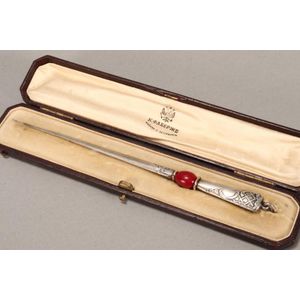Russian Acanthus Motif Paper Knife with Porphyry Handle
Russian paper knife, of slender tapering form, accented with acanthus motifs and lattice patterning to handle terminating to porphyry and tapering blade, length 18 cm, boxed Provenance: Purchased Sotheby's Belgravia, 21/7/76, lot 116
You must be a subscriber, and be logged in to view price and dealer details.
Subscribe Now to view actual auction price for this item
When you subscribe, you have the option of setting the currency in which to display prices to $Au, $US, $NZ or Stg.
This item has been sold, and the description, image and price are for reference purposes only.
- Porphyry - In geology, porphyry is a type of igneous rock with a distinctive texture. It has large, visible crystals (called phenocrysts) embedded in a fine-grained groundmass. In the ancient world, porphyry was a highly prized material used for sculptures, sarcophagi, and other decorative objects. Porphyry wasn't widely used in furniture throughout the 19th century, but was used as a luxury and prestigious material.
Due to its high cost and difficulty in working with, porphyry was primarily used for smaller accent pieces or decorative elements on furniture. This could include tabletops, inlays, veneers, or ornamental details on legs or columns. It was also used for furniture pieces commissioned for royalty, wealthy patrons, or important public buildings. For example, some European palaces feature furniture with porphyry elements. - Acanthus - A stylized leaf motif, one of the primary decorative elements of classical Greek and Roman architecture, derived from the genus of flowering plants in the family Acanthaceae, native to tropical and subtropical regions of the Mediterranean area. It is a common element in classical Greek and Roman design, and is often seen in Corinthian and Composite order columns and used as a decorative element in English, European and Australian furniture, particularly on the curve of a leg, and as decoration for a corbel.
This item has been included into following indexes:
